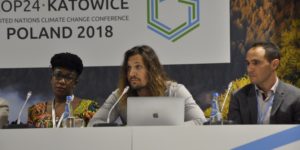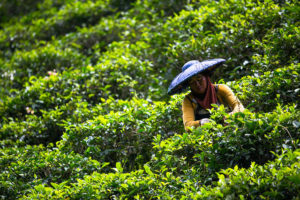
Failing to address gender equality in forest- and tree-based climate initiatives can have negative implications for gender equity, while also potentially undermining the efficiency and sustainability of climate efforts, according to gender specialist Markus Ihalainen, speaking at recent UN climate talks.
Forested landscapes play a key role in all 1.5 degree pathways modelled by the Intergovernmental Panel on Climate Change (IPCC) in its recent report.
At the same time, they also provide many functions critical to adaptation, said Ihalainen a researcher with the CGIAR Research Program on Forests, Trees and Agroforestry (FTA) and its partner institution the Center for International Forestry Research (CIFOR), at the 24th Conference of the Parties (COP24) to the United Nations Framework Convention on Climate Change (UNFCCC) held in Katowice, Poland.
“The long-term success of the required land-use changes is ultimately dependent on the contributions of both women and men who are using those lands for their livelihoods,” Ihalainen said during a presentation in the UK “Green is Great” pavilion on the sidelines of the annual conference. “At the same time, interventions that do not take gender and other aspects of social diversity into account often risk adversely impacting marginalized groups.”
Read more: FTA at COP24
NETWORK GROWTH
Despite an increasing body of literature on the topic, forest policymakers often overlook gender considerations. However, gender blindness is a problem that makes women’s participation and contributions invisible and allows forest management to be incorrectly treated as “gender neutral.”
For example, while many Intended Nationally Determined Contributions (INDCs) include forest-sector related targets, the majority of the 25 INDCs reviewed by CIFOR fail to mention gender or refer to it only superficially. Under the terms of the 2015 Paris Agreement on climate change, INDCs establish guidelines intended to hold the increase in global average temperature to well below 2 degrees Celsius, to pursue efforts to limit the increase to 1.5 degrees Celsius, and achieve net zero emissions in the second half of the 21st century.

Studies of women’s involvement in conservation programs have showed that inclusive processes could yield more equitable outcomes, while more inclusive forest user groups also tend to demonstrate better environmental performance, Ihalainen said, adding that such synergies must be built, not simply assumed.
Ihalainen referred to recent findings from CIFOR’s Global Comparative Study on REDD+. The first phase of the research, spanning across 16 pilot project sites in six countries, investigated community participation in Reducing Emissions from forest Degradation and Deforestation (REDD+) design and implementation.
The study found that women often participated far less than their male counterparts and, even when women participated, they often lacked the information and awareness of REDD+ needed for their participation to be effective.
Three years later, the research team returned to the same sites to assess the impact of REDD+ on subjectively defined wellbeing.
“Between phase one and phase two of the pilot projects there was a significant decline observed in the subjective wellbeing of the women in comparison to men in the same villages, as well as in comparison to women and men in control sites with no REDD+ intervention,” said Ihalainen, who also delivered a presentation at a session hosted by FTA partner institution the World Agroforestry Centre (ICRAF).
Read more: Global commitment growing for gender equality in climate action
While more work is needed on the specific causal mechanisms, combining the two datasets would suggest that the failure to meaningfully consider gender issues could be associated with a relative decline in women’s wellbeing.
But in addition to the potentially detrimental impact on gender equality, gender-blind climate action also risks jeopardizing efficiency and long-term sustainability. Ihalainen pointed to four areas where gender considerations are crucial.
Land tenure security is a critical incentive for long-term investments in sustainable landscape management practices, but in general, land rights and tenure security for women are weak. A study of women farmers study of women farmers in Ethiopia found that land insecure women were less likely to adopt sustainable agroforestry practices than men. However, when they had secure land tenure they were actually more likely than men to do so.
Resolving gender division of labor concerns can also be an incentive for more sustainable activities. Often, agroforestry practices and tree planting programs are reliant on women’s labor, but in many areas women do not have rights to trees when they grow.

Weaker decision-making opportunities also put women at a disadvantage. For example, in Nepal, male-dominated forest user groups opted to protect valuable timber species, often benefitting men, while removing many food and medicinal plants as weeds.
A study in Vietnam revealed that most women preferred non-cash benefits from REDD+ projects. However, the programs were structured around cash payments, which were ultimately controlled by men.
In addition to reinforcing or even exacerbating gender inequalities, all of the aforementioned issues also serve as disincentives to women’s continued participation and contributions, ultimately jeopardizing the long-term sustainability of the environmental objectives.
Read more: Women left on sidelines of decisions about forest management
ACTIVE PARTICIPATION
“Addressing gender equality in landscape management allows people to make decisions about what happens in their lives and livelihoods and also increases the likelihood of successful climate action,” Ihalainen said. “However, synergies cannot just be assumed, it is important that they are built through gender analysis, robust data and proper planning. Tokenistic add-on approaches are not enough to safeguard women’s rights.”
Importantly, sectoral efforts to enhance gender equity in participation and benefit sharing, for instance, can be supported by broader efforts aimed at addressing gender equality.
Ihalainen offered an example from Nyandarua, Kenya, where the Kenya Forest Service leveraged the constitutional requirement to have a one third gender balance in all elected bodies to increase women’s participation in community forest associations.
Critically, efforts to enhance gender equity in program activities need to be complemented with measures and targets directed at addressing the structural causes of gender inequality. Considering gender equality and women’s empowerment as a goal in itself can also allow for identifying synergies between mitigation, adaptation and equality.
This is particularly important in the land sector, where mitigation efforts often need to co-exist alongside other land-use needs. Ihalainen offered an example from Burkina Faso, where CIFOR researchers compared a number of restoration options, including timber monocultures and shea parklands.
The team found that while timber monocultures demonstrated slightly higher carbon sequestration values, shea parklands – in addition to carbon storage – offered multiple cobenefits, including income-generation opportunities to women and enhanced household food security.
Ihalainen argued for the importance of climate policies and programs to complement process-related gender mainstreaming targets with progress-oriented indicators, aimed at addressing structural inequalities underlying differentiated vulnerabilities and capacities.
Many of these targets have already been identified and agreed upon in the UN Sustainable Development Goals framework. Formulating clear progress-related targets would also allow to hold policymakers, implementers and donors accountable for their impacts on gender equality, he said.
“This is why it is so important to make sure that references to human rights and gender equality feature prominently in the texts here in Katowice, where we are discussing the modalities of implementing, monitoring and reporting on the Paris Agreement,” Ihalainen added.
By Julie Mollins, originally published at CIFOR’s Forests News.
For more information on this topic, please contact Markus Ihalainen at m.ihalainen@cgiar.org.
This work forms part of the Global Comparative Study on REDD+











